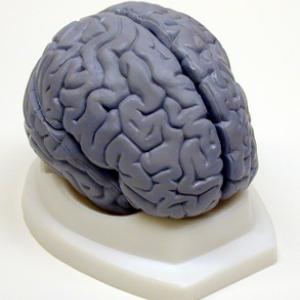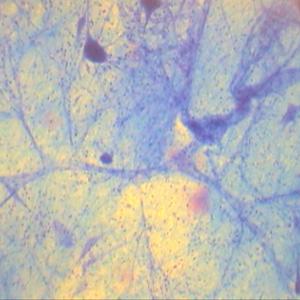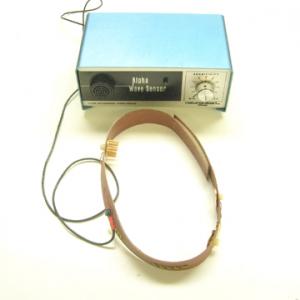College of Liberal Arts & Sciences
11A10.20 - Model of the Human Brain
No advanced notice required. Parts of the brain are numbered and an explanation of these parts can be found in the file. The laser etched crystal cube while small is a very good example of the brain network.
The Alpha Wave detector will show one aspect of brain function if operated properly.
- Peter S. Given Jr., "Studying the Brain's Alpha Wave Patterns in a High School Laboratory", TPT, Vol. 10, #2, Feb. 1972, p. 93.
- Maurice M. Klee, "A Charge Analysis of Non-Invasive Electrical Brain Stimulation", AJP, Vol. 91, #4, April 2023, p.264.
- Barry Horwitz, "Physics Course on Information Processing in the Nervous System", AJP, Vol. 42, #3, Mar. 1974, p. 198.
- Sam Van Wassenbergh, Maja Mielke, "Why Woodpeckers Don't Get Concussions", Physics Today, Vol. 77, #1, Jan. 2024, p. 54.
- Toni Feder, "Neuroscientists Network to Study the Whole Brain", Physics Today, Vol. 71, #5, May 2018, p. 26.
- R. Mark Wilson, "Imaging A Mouse's Brain Through its Skull", Physics Today, Vol. 68, #9, Sep. 2015, p. 14.
- Charles Day, "Toward Imaging the Brain's Tiniest Arteries", Physics Today, Vol. 67, #1, Jan. 2014, p. 16.
- Toni Feder, "Putting Heads Together for Concussion Research", Physics Today, Vol. 66, #12, Dec. 2013, p. 23.
- Toni Feder, "The Brain is Big Science", Physics Today, Vol. 66, #12, Dec. 2013, p. 20.
- Front Cover Page, Physics Today, Vol. 66, #12, Dec. 2013.
- Johanna L. Miller, "New Technique Makes Brains Transparent", Physics Today, Vol. 66, #6, June 2013, p. 14.
- Humberto Mestre Et al., "Cerebrospinal Fluid Influx Drives Acute Ischemic Tissue Swelling", Science, Vol. 367, # 6483, March 13, 2020, p. 1211.
- "CLARITY Makes it Perfectly Clear", Science, Vol. 342, #6165, Dec. 2013, p. 1434.
- Robert J. Zatorre, "Predispositions and Plasticity in Music and Speech Learning: Neural Correlates and Implications", Science, Vol. 342, #6158, Nov. 2013, p. 585.
- Nicholas B. Turk-Browne, "Functional Interactions as Big Data in the Human Body", Science, Vol. 342, #6158, Nov. 2013, p. 580.
- Hae-Jeong Park and Karl Friston, "Structural and Functional Brain Networks: From Connections to Cognition", Science, Vol. 342, #6158, Nov. 2013, p. 579.
- Nikola T. Markov, Mária Ercsey-Ravasz, David C. Van Essen, Kenneth Knoblauch, Zoltán Toroczkai, and Henry Kennedy, "Cortical High-Density Counterstream Architectures", Science, Vol. 342, #6158, Nov. 2013, p. 578.
- Peter Stern, "Connection, Connection, Connection...", Science, Vol. 342, #6158, Nov. 2013, p. 577.
- Emily Underwood, "Short-Circuiting Depression", Science, Vol. 342, #6158, Nov. 2013, p. 548.
- Front Cover Page, Science, Vol. 342, #6158, Nov. 2013.
- Mitchell Glickstein and Alan R. Gibson, "Visual Cells in the Pons of the Brian", Scientific American, Vol. 235, #5, Nov. 1976, p. 90.
- Rodolfo R. Llinás, "The Cortex of the Cerebellum", Scientific American, Vol. 232, #1, Jan. 1975, p. 56.
- Lennart Heimer, "Pathways in The Brain", Scientific American, Vol. 224, #1, July 1971, p. 48.
- Lydia Chain, "Trojan Horse in the War on Cancer", Popular Science, Vol. 288, #2, Mar/Apr. 2016, p. 26.
- Matt Giles, "Big Idea: The Brain's Best-Kept Secret" Popular Science, Vol. 288, #1, Jan/Feb 2016, p. 46.
- Joe DeLessio, "Tackling Brain Trauma Head-On", Popular Science, Vol. 288, #1, Jan/Feb 2016, p. 32.
- Megan Scudellari, "10 Brain Myths Busted", Popular Science, Vol. 287, #5, Nov. 2015, p. 48.
- Daniel Engber, "Why Don't Woodpeckers Get Brain Damage?", Popular Science, Vol. 286, #9, Sept. 2014, p. 79.
- Adam Piore, "The Neuroscientist Who Wants To Upload Humanity To A Computer", Popular Science, Vol. 286, #5, May 2014, p. 54.
- Mary Beth Griggs, "When Brain Cells Excite", Popular Science, Vol. 286, #5, May 2014, p. 35.
- Virginia Hughes, "Stop Looking for 'Hardwired' Differences in Male and Female Brains", Popular Science, Vol. 286, #4, Apr. 2014, p. 34.
- Erik Sofge, "Computers Decode our Brains", Popular Science, Vol. 286, #1, Jan 2014, p. 46.
- Pat Murphy, Ellen Macaulay, and the Staff of The Exploratorium, "Your Brain", Exploratopia, p. 67 - 81.
- "Brainiac", Uncle John's Bathroom Reader, p. 264.
- Vicki Cobb and Kathy Darling, "Write Wrong", Bet You Can!, p. 16.
- Janice VanCleave, "3. Brainpower", The Human Body for Every Kid, p. 21 - 27.
- Curt Suplee, "Emotion and Memory", Everyday Science Explained, National Geographic, p. 260 - 261.
- Curt Suplee, "Basics of the Brain", Everyday Science Explained, National Geographic, p. 244 - 245.
- Curt Suplee, "Of Heart Attacks and Brain Attacks", Everyday Science Explained, National Geographic, p. 230 - 231.
- Curt Suplee, "The Control Center", Everyday Science Explained, National Geographic, p. 222 - 223.
- Ron Hipschman and Jad King, "Recipe No. 111: Mirrorly A Window", Exploratorium Cookbook II, p. 111-1 - 111-4.
- Sara Stein, "Thoughts", The Science Book, p. 244.
- Sara Stein, "Your Secret Face", The Science Book, p. 254.
Disclaimer: These demonstrations are provided only for illustrative use by persons affiliated with The University of Iowa and only under the direction of a trained instructor or physicist. The University of Iowa is not responsible for demonstrations performed by those using their own equipment or who choose to use this reference material for their own purpose. The demonstrations included here are within the public domain and can be found in materials contained in libraries, bookstores, and through electronic sources. Performing all or any portion of any of these demonstrations, with or without revisions not depicted here entails inherent risks. These risks include, without limitation, bodily injury (and possibly death), including risks to health that may be temporary or permanent and that may exacerbate a pre-existing medical condition; and property loss or damage. Anyone performing any part of these demonstrations, even with revisions, knowingly and voluntarily assumes all risks associated with them.


